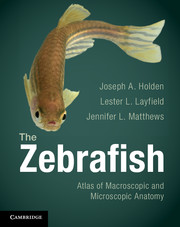Book contents
- Frontmatter
- Contents
- Preface
- Acknowledgments
- Chapter 1 Introduction
- Chapter 2 Cross section and longitudinal section atlas
- Chapter 3 Integument (skin)
- Chapter 4 Digestive system
- Chapter 5 Respiratory system
- Chapter 6 Circulatory system
- Chapter 7 Liver and gallbladder
- Chapter 8 Pancreas
- Chapter 9 Endocrine organs
- Chapter 10 Kidney
- Chapter 11 Reproductive system
- Chapter 12 Sensory systems
- Chapter 13 Central nervous system
- Chapter 14 Miscellaneous structures
- Chapter 15 Musculoskeletal system
- Index
- References
Chapter 5 - Respiratory system
Published online by Cambridge University Press: 05 February 2013
- Frontmatter
- Contents
- Preface
- Acknowledgments
- Chapter 1 Introduction
- Chapter 2 Cross section and longitudinal section atlas
- Chapter 3 Integument (skin)
- Chapter 4 Digestive system
- Chapter 5 Respiratory system
- Chapter 6 Circulatory system
- Chapter 7 Liver and gallbladder
- Chapter 8 Pancreas
- Chapter 9 Endocrine organs
- Chapter 10 Kidney
- Chapter 11 Reproductive system
- Chapter 12 Sensory systems
- Chapter 13 Central nervous system
- Chapter 14 Miscellaneous structures
- Chapter 15 Musculoskeletal system
- Index
- References
Summary
Respiration in fish is achieved by bringing water through the lips into the buccal cavity and hence, into the pharynx and over the gills (Figure 5.1). Gill respiration only functions effectively when water moves in a unilateral direction over the gill membranes,. Most fishes pump water over their gills by alternately relaxing and contracting the buccal chamber (anterior to the gills) and the opercular chamber (posterior to the gills),. A second method for achieving water flow is by swimming with the mouth open (ram ventilation) forcing water through the pharynx, over the gills, and out the opercular chamber and gill slits,.
Gills
Like terrestrial organisms, oxygen is required for ATP production and basic body metabolism in fish. Unlike terrestrial organisms, fish live in an oxygen poor environment. The gills are the structures that allow fish to efficiently extract oxygen from the water for use in metabolic reactions.
The zebrafish gills are composed of four bilateral gill arches and can be seen in the ventral oropharynx (Figure 5.1). The gill arches are supported by bony and cartilaginous tissue and contain skeletal muscle. They are richly innervated by the facial, glossopharyngeal, and vagus cranial nerves. They are covered by a mucinous epithelium continuous with that of the oropharynx. Extending from each gill arch are two paired primary gill filaments (primary lamella) (Figure 5.2). The primary gill filaments are supported by cartilage: sometimes referred to as a cartilaginous ray (Figures 5.3 and 5.4). Easily seen in the primary gill filaments are the large central venous sinuses (Figures 5.3 and 5.4). Perpendicular from each primary filament are many thin-walled secondary gill filaments (secondary lamella) (Figure 5.2). The secondary gill filaments provide a large surface area and are the site for oxygen uptake and the release of carbon dioxide and ammonia. The secondary gill filaments are lined by thin squamous cells referred to as pavement cells (Figures 5.3, 5.6, and 5.7). The pavement cells are epithelial in nature and stain positively for keratins by immunohistochemistry (Figure 5.5). Red blood cells are easily seen in the secondary gill filament.
- Type
- Chapter
- Information
- The ZebrafishAtlas of Macroscopic and Microscopic Anatomy, pp. 68 - 75Publisher: Cambridge University PressPrint publication year: 2013



